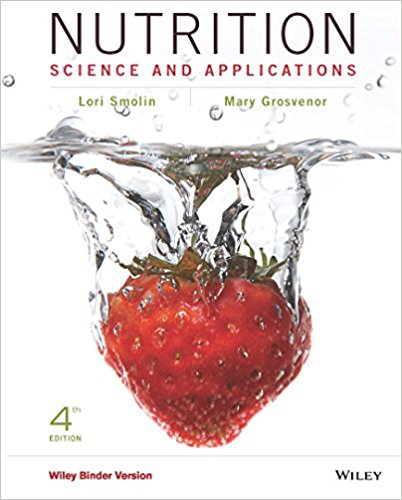Test Bank For Nutrition Science and Applications, Binder Ready Version, 4th Edition Smolin, Grosvenor
Original price was: $75.00.$25.00Current price is: $25.00.
Test Bank For Nutrition Science And Applications, Binder Ready Version, 4th Edition Smolin, Grosvenor is an essential resource for anyone who wants to understand and apply the latest nutrition science. The Test Bank provides over 2,000 practice questions and answers, as well as guidance on how to approach and answer each question.
In addition, the Test Bank offers a wealth of valuable resources such as illustrations, charts, and tables that help to clarify key concepts. The Test Bank is an essential tool for students who want to excel in their nutrition studies. Whether you are new to the subject or a seasoned veteran, the Test Bank will help you to deepen your understanding of nutrition science and its applications.
Digital item No Waiting Time Instant Download
ISBN: 978-1-119-22464-8, ISBN: 9781119224648
Description
Test Bank For Nutrition Science and Applications, Binder Ready Version, 4th Edition Smolin, Grosvenor
Course Title: Smolin4e
Chapter Number: 3
Question Type: Multiple Choice
1) _________ are units of matter that cannot be further broken down by chemical means.
a) Organic compounds
b) Cells
c) Atoms
d) Solvents
Answer: c
Difficulty: Easy
Learning Objective: LO 3.1 Describe the organization of life and the organ systems that play a role in obtaining and using nutrients.
Section Reference: Section 3.1 Food Becomes Us
2) Nutrients classified as “organic molecules” have a molecular structure which contains the element:
a) carbon.
b) oxygen.
c) nitrogen.
d) sulfur.
Answer: a
Difficulty: Easy
Learning Objective: LO 3.1 Describe the organization of life and the organ systems that play a role in obtaining and using nutrients.
Section Reference: Section 3.1 Food Becomes Us
3) Which of the following sequences is organized from the simplest to the most complex arrangement?
a) atoms : molecules : tissues : organs
b) molecules : tissues : atoms : organs
c) tissues: atoms : molecules : organs
d) atoms : organs : tissues : molecules
Answer: a
Difficulty: Easy
Learning Objective: LO 3.1 Describe the organization of life and the organ systems that play a role in obtaining and using nutrients.
Section Reference: Section 3.1 Food Becomes Us
4) The movement of food through the digestive tract is regulated by:
a) the endocrine and nervous systems.
b) the lymphatic and muscular systems.
c) the respiratory and urinary systems.
d) the cardiovascular system.
Answer: a
Difficulty: Medium
Learning Objective: LO 3.1 Describe the organization of life and the organ systems that play a role in obtaining and using nutrients.
Section Reference: Section 3.1 Food Becomes Us
5) The most important roles of the digestive system include digestion and:
a) metabolism.
b) absorption.
c) circulation.
d) excretion.
Answer: b
Difficulty: Medium
Learning Objective: LO 3.2 Explain the gastrointestinal tract structure and the roles of mucus, enzymes, nerves, and hormones in the digestive tract.
Section Reference: Section 3.2 The Digestive System
6) The internal lining of the gastrointestinal tract is the:
a) submucosa.
b) serosa.
c) muscularis.
d) mucosa.
Answer: d
Difficulty: Easy
Learning Objective: LO 3.2 Explain the gastrointestinal tract structure and the roles of mucus, enzymes, nerves, and hormones in the digestive tract.
Section Reference: Section 3.2 The Digestive System
7) The digestive tract begins at the _________ and ends at the _________.
a) esophagus; small intestine
b) mouth; transverse colon
c) esophageal sphincter; pylorus
d) mouth; anus
Answer: d
Difficulty: Easy
Learning Objective: LO 3.2 Explain the gastrointestinal tract structure and the roles of mucus, enzymes, nerves, and hormones in the digestive tract.
Section Reference: Section 3.2 The Digestive System
8) Transit time is the rate at which food:
a) moves through the digestive tract.
b) is swallowed.
c) is absorbed into the blood.
d) is broken down into chyme.
Answer: a
Difficulty: Easy
Learning Objective: LO 3.2 Explain the gastrointestinal tract structure and the roles of mucus, enzymes, nerves, and hormones in the digestive tract.
Section Reference: Section 3.2 The Digestive System
9) Which of the following is NOT a product released by the GI tract?
a) Mucus
b) Enzymes
c) Chyme
d) Hormones
Answer: c
Difficulty: Easy
Learning Objective: LO 3.2 Explain the gastrointestinal tract structure and the roles of mucus, enzymes, nerves, and hormones in the digestive tract.
Section Reference: Section 3.2 The Digestive System
10) Which of the following is NOT an accessory organ of the digestive system?
a) Liver
b) Pancreas
c) Salivary glands
d) Kidney
Answer: d
Difficulty: Easy
Learning Objective: LO 3.2 Explain the gastrointestinal tract structure and the roles of mucus, enzymes, nerves, and hormones in the digestive tract.
Section Reference: Section 3.2 The Digestive System
11) Chewing is an important digestive function because it improves the functionality of:
a) enzymes.
b) hormones.
c) mucus.
d) peristalsis.
Answer: a
Difficulty: Medium
Learning Objective: LO 3.2 Explain the gastrointestinal tract structure and the roles of mucus, enzymes, nerves, and hormones in the digestive tract.
Section Reference: Section 3.2 The Digestive System
12) What enzyme prevents bacterial growth in the mouth?
a) Amylase
b) Lysozyme
c) Bacteriocidase
d) Lipase
Answer: b
Difficulty: Medium
Learning Objective: LO 3.3 Discuss how nutrients are digested and absorbed in the digestive tract.
Section Reference: Section 3.3 Digestion and Absorption
13) Which structure prevents swallowed food from entering the trachea?
a) Tongue
b) Pharynx
c) Esophageal sphincter
d) Epiglottis
Answer: d
Difficulty: Easy
Learning Objective: LO 3.3 Discuss how nutrients are digested and absorbed in the digestive tract.
Section Reference: Section 3.3 Digestion and Absorption
14) The pharynx is a cavity shared by the digestive tract and the:
a) urinary tract.
b) respiratory tract.
c) pancreatic duct.
d) common bile duct.
Answer: b
Difficulty: Medium
Learning Objective: LO 3.3 Discuss how nutrients are digested and absorbed in the digestive tract.
Section Reference: Section 3.3 Digestion and Absorption





Be the first to review “Test Bank For Nutrition Science and Applications, Binder Ready Version, 4th Edition Smolin, Grosvenor”